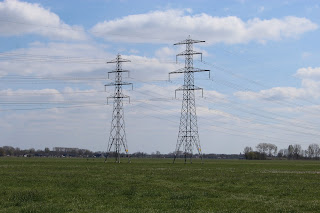On my walks through town and country, I do come across some monuments that are reminders of World War II. There may be fewer and fewer people who actually remember the actual war (my Dad for example was born a month after the war had ended), but it should still be remembered.
The photo at the top may not look like much, but those pylons were not there on June 22nd, 1944 when a Lancaster Bomber from the 50th squadron of the RAF came down right where those pylons are now. It was the middle of the night and the bomber had just returned from a night raid on Scholven-Buer, near Essen in Germany, when it got shot at by a German night fighter (likely to have been a Heinkel) at 2.20 am.
Two of the air crew were killed in the crash (JF Lane, the air gunner and FH Shorter, the mid upper gunner), the other six made it out alive by using their parachutes. One member (KHC Ingram, the flight engineer) was captured and shot in October with 6 members of a resistance group. Three more men were also captured and ended up in POW camps in Poland (TB Cole, the pilot; AG Beresford, the bomb aimer and PFJ Hayes, the rear gunner). The remaining two members made it back to England (J Craven, the navigator and EJ Blakemore, the wireless operator).
 |
| An ordinary house with an ordinary couple living there. It just so happened that couple was Jewish. |
Menno (a sales supervisor) and his wife Annie Troostwijk-Hijmans lived in the ordinary house in the photo. On March 2nd, 1943 at 2 in the morning he and his wife are captured. Two days later they are transported to Westerbork. Less than a week after that Menno was sent to Sobibor. He was not killed on arrival, but was one of the forced labourers tasked with sorting clothing, jewellery etc. Around the middle of April he and 69 others were killed on 'suspicion' of trying to escape. He was 35.
 |
| Menno and Annie |
We mustn't forget the sacrifices made for us by all those airmen, soldiers and sailors who fought to save Europe. Nor must we forget the sacrifices made by all those Jewish, Sinti, Roma, Jehova's Witnesses, Homosexuals, Polish, Russian and others who were killed only because they weren't 'normal'. Whatever normal is!
Information and photos of Dora, Bram, Menno and Annie were found on joodsmonument.nl






I was born in 1943 so my mother was allowed to go to her parents on the countryside as she was pregnant to escape the heavy bombing of Frankfurt. From all the war I only know probably like your father the battle for food ! We children didn't suffer but for our parents it was very hard to find something to eat !
ReplyDeleteHari OM
ReplyDeleteMara - this is a moving and meaningful post. I too believe this history must be remembered. Thank you for this... YAM xx
The Stumbling Stones I had heard of, but never seen in my own home town. I was at the same delighted and horrified when I found a few.
DeleteIt's a sobering post and it seems right to remember. I wonder if it seems as right to the kids, and I wonder if they will still remember in another 50 years.
ReplyDeletewhat a beautiful post Mara. Sometimes folks try to erase history they don't like/approve. History made us who we are and we need to learn from it good and bad
ReplyDeleteHugs Cecilia
Thanks for telling us the stories of the people memorialized in those stumbling stones. I hope they help people to never forget what happened all those years ago.
ReplyDeleteThanks for all the information. Oma, my mom, lived through WW II, and had a job not far from a concentration camp. Her boss tried to help those poor people, was caught, and sent to the Russian Front, never to be heard of again. She has lots of stories about the war, and the bombs dropping, and starvation. We need to never forget what that was like!
ReplyDeleteWhat a wonderful post, and we also agree, we should never forget!
ReplyDeleteI just finished and ebook, "The Girls in the Attic". The perspective of a Jewess German during the latter days of the war with all the Allied bombings. Very sobering. We saw many of the stumbling stoned during our 2016 visit to Europe. Again, sobering. Klem
ReplyDeleteI had heard of the Stumbling Stones, but never seen them. It was a surprise to see them, even though I knew they were in my home town as well.
Delete